Menu
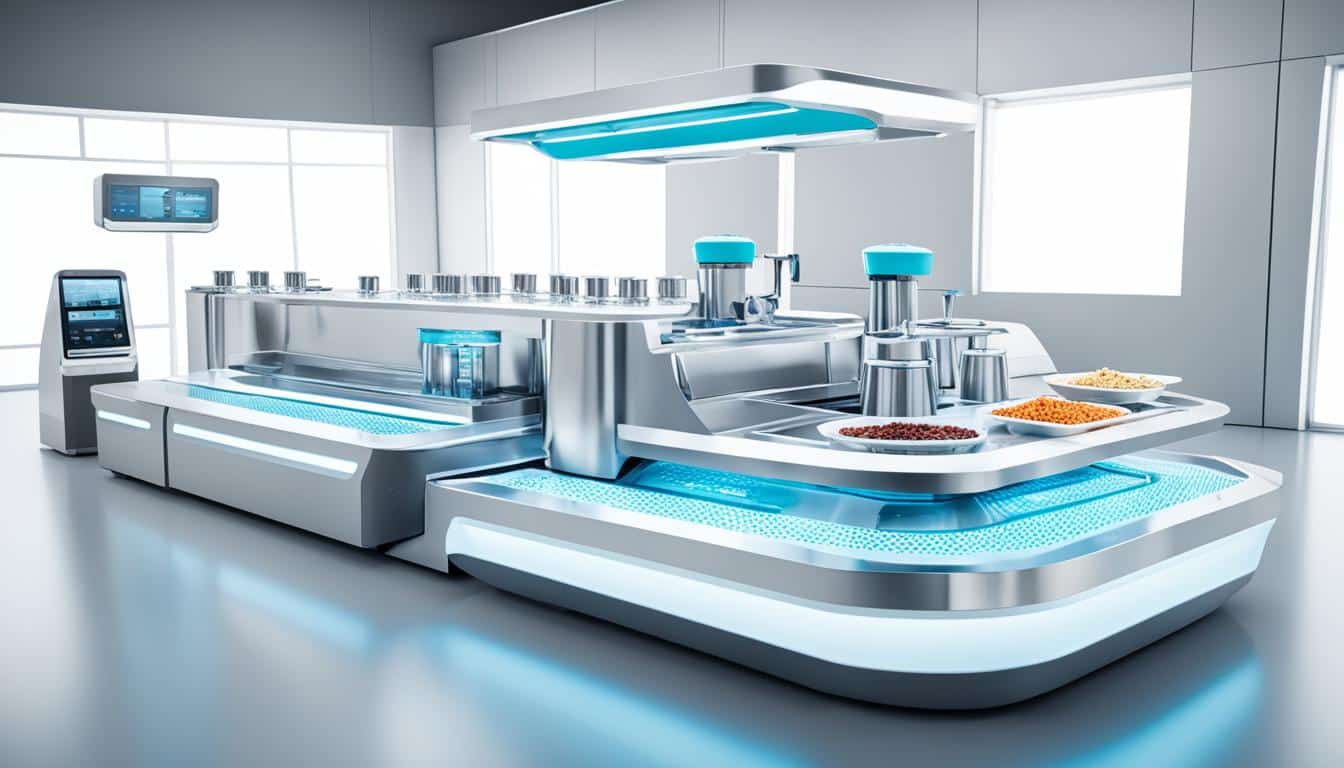
By 2028, the AI in agriculture market is set to grow from USD 1.7 billion to USD 4.7 billion. The growth is thanks to automated feeding systems, now worth USD 4.1 billion as of 2023. These systems have a strong compound annual growth rate (CAGR) of 7%.
Advanced technologies like the Kai Zen 5 robot and cloud-based analysis are key. They help farmers measure feed exactly. This increases the quality of how we manage animals and boosts green and smart farming.
Key companies, such as Forever Feed Technologies, are heavily investing in these technologies. This is securing the place of smart feeding in the future of farming.
Automated feeding systems change the way we feed animals. They mix sensors, robots, and data crunching. This results in feeding that’s exact, efficient, and always watched over. These systems have upended how we take care of livestock and pets. They’re making the old ways obsolete.
These are high-tech setups. They handle feed in a very precise way. They make sure every animal gets the right amount of food, depending on needs like age. This high-tech feeding also makes animals eat more often. This leads to better health, more babies, and more products. The bar for feeding animals is always rising with new tech.
Feeding tech has come a long way, showing how farming has improved. New systems like the Lely Vector and Lely Cosmix boost profit and animal health. The Lely Vector lets cows eat whenever, making them eat more. The Lely Cosmix helps cows make more milk by feeding them concentrated food in just the right amounts.
Systems like the Lely Calm help growing calves. They give milk at the perfect temperature and track how much milk they drink. These systems really help farm life get better. They help animals and farms be more efficient.
These automatic feeders aren’t just for farms. They can work in many other areas too, from making drugs to putting together gadgets. When you add robots to these systems, everything flows smoothly. This shows just how powerful this technology can be.
| System Feature | Benefits |
|---|---|
| Lely Vector | 24/7 access to feed, increased fodder ingestion, improved profitability. |
| Lely Cosmix | Higher milk yield, improved rumen health, precise portion control. |
| Lely Calm | Optimal temperature milk delivery, insights into milk intake, enhanced calf development. |
| PigTek ALL-OUT® | Weather-resistant feed bins, enhanced management control. |
| Chore-Time and PigTek Systems | High feed delivery rates, efficient operations, reduced feed waste. |
By using and adapting these systems, we can really make a difference in how well animals are fed. And that leads to better productivity overall.
The market for automated feeding systems is now worth a staggering USD 9.5 billion in 2022. This number shows the big interest in smart feeding solutions. It points to a market that is likely to grow fast, reaching a value of USD 15.3 billion by 2030.

Today, automated feeding systems are making a big impact, with a value of USD 9.5 billion. This is due to the strong demand for smart feeding solutions. The biggest part of this market, about 55-57%, comes from products for ruminants. The need for more dairy products all over the world is a big reason for this.
Experts expect the market to keep growing steadily at 7.1% yearly. This is thanks to new technology and the move towards fully integrated systems. In Europe, for instance, the market was worth USD 4.4 billion in 2022. Its growth is driven by better software for farming and smarter feeding plans.
North America is also seeing big changes with the second-highest market share. Here, innovations in feeding systems are leading the way to growth.
Take a look at the table to see more about the market’s current situation and what’s driving its growth:
| Region | Market Value (2022, USD Billion) | Key Segment | Growth Drivers |
|---|---|---|---|
| Europe | 4.4 | Ruminants | Technological advancements, software integration |
| North America | Second-largest | Fully integrated systems | Innovations in equipment, increased demand |
| Global | 9.5 (total) | Rail-guided systems | Dependability, decreased daily feeding burden |
This table shows the big market potential for automated feeding systems. It’s a key area for both investing and coming up with new ideas.
Advanced technologies are changing how we manage livestock. Sensor tech and data analytics are key. They make feeding more precise and efficient.
Sensor tech is changing the game in livestock feeding. It helps us watch and control our herds better. With sensors, we can give each animal the right nutrients. This is great for their health and cuts down on wasted food. It allows for custom feeding plans, perfect for big herds. This was hard to do before.
Data analytics has made a big difference in farming. It helps farmers feed their animals better. By looking at data, farmers can choose the best food for their animals. This means healthier and more productive livestock.
Data also helps with timing. Systems that detect when cows are ready to mate save a lot of time. They check cow activities and signs to know the best moment for mating. This makes the mating process better and increases the chance of cows getting pregnant.
| Technological Tool | Benefit |
|---|---|
| Automated Feeding Systems | Ensures right nutrient delivery, reduces waste, supports individualized feeding programs |
| Genetic Selection Tools | Provides insight into genetic makeup, selects traits for disease resistance and productivity |
| Heat Detection Systems | Monitors cows’ behaviour and physiological parameters, improves pregnancy success rates |
| Drones | Offers real-time herd and pasture monitoring, enhances sustainability and profitability |
| Wearable Technology | Collects real-time data, supports early illness detection and stress monitoring |
| RFID | Provides unique identification and tracking, streamlines herd management |
| AI and ML | Automates and improves predictive insights for better herd management |
The mix of sensors and data analytics boosts how we feed livestock. It’s key for top performance. It ensures animals get just what they need for great health and work.
Automatic systems are changing the game in looking after livestock. They make feeding more precise and efficient. This means each animal gets exactly what it needs, which boosts how well they eat and their overall health. The Lely Vector system is a great example. It feeds cows regularly around the clock. This leads to better health, more babies, and increased milk production.
The Lely Juno and Lely Cosmix systems are standouts in getting the job done right. The Lely Juno gives cows easy access to roughage. This improves their stomach health. The Lely Cosmix makes sure cows get the right amount of concentrate, which boosts milk and makes cows healthier. When calves are fed using the Lely Calm system, they grow into healthy, productive dairy cows.
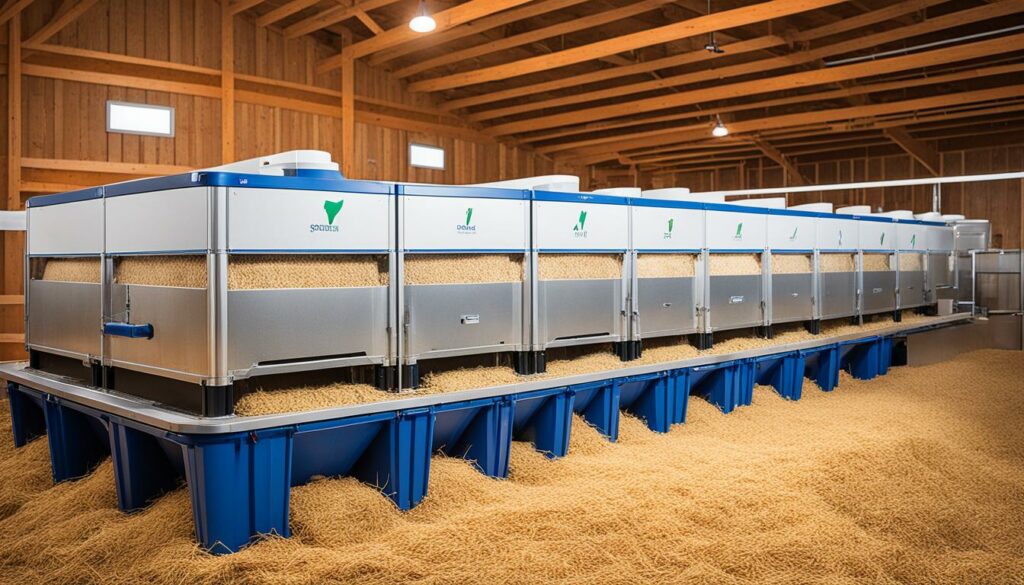
Automated feeding is also a win for the wallet. It’s not just cheap to run, but pays for itself quickly. Some systems can start saving you money in under a year. This quick financial return means getting these systems makes good sense. Plus, they keep track of how much milk your cows drink and how fast. This data is gold for making smart choices about your animals and running your farm more efficiently.
The systems promote constant oversight and adjustments, leading to significant cost savings through optimised feed usage and reduction in wastage.
Robotic feeding systems are changing how we farm. They use real-time data and automated features for precise and efficient farming. These systems are key as we look to increase food but use less land by 2050.
Robotic systems use sensors, AI, and machines to feed animals. They adjust feed based on real-time data, improving schedules and amounts. For example, the Lely Vector robot boosts milk and cuts waste by feeding cows what they need.
Seeing robots in action proves their worth. In the UK, Warwick Agri-Tech uses autonomous vehicles and AI for farming. In the US, robotic milking benefits farms by lowering costs and making cows happier. Warwick’s research in the UK tests these new techs widely.
Farms using high-tech feeding report big wins. A survey found they save on costs, care better for animals, and perform better thanks to robots. The Lely Vector, for instance, cuts fuel costs and ups milk per cow daily.
| System | Benefit | Location |
|---|---|---|
| Lely Vector | Increase in milk production by 4 lbs/day, fuel savings of up to $10,000 annually | USA |
| Warwick Agri-Tech Projects | Optimised product handling and sapling tree grading through automation | UK |
Yet, robots face challenges like high costs and needing skilled people to run them. But, the promise of boosting farms’ productivity and being good for the Earth makes them worth it. They offer a bright future for farming.
Advanced technology is making a big difference in how we care for livestock. New automated systems help create special diets for animals. These diets reduce stress and make animals healthier. Farmers use these tools to craft feeds that exactly meet each animal’s needs. This helps them perform their best and stay well.
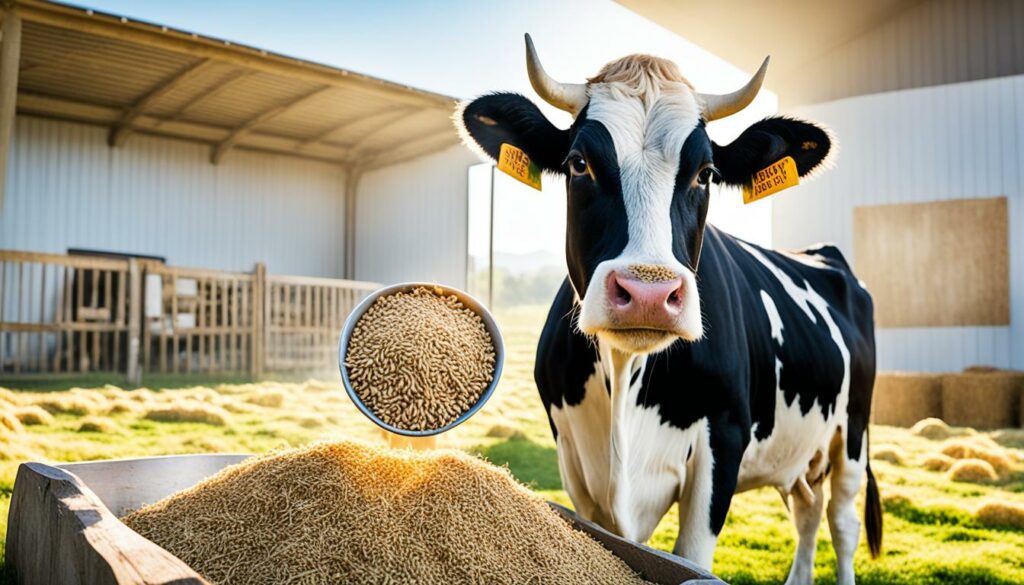
Feeding animals the right amount matters a lot for their health. Precision systems take into account an animal’s type, age, and what it needs. Such an approach can reduce how much protein the animal eats. This means they produce less nitrogen waste. It’s good for the farm’s budget and the planet.
Keeping animals calm and healthy is a top goal. Studies show this can make farms more profitable. By feeding animals just what they need, less is wasted. This helps their bodies digest food better. And, that means they are healthier and more efficient.
| Benefit | Impact | Statistic |
|---|---|---|
| Decreased Protein Intake | Reduces nutrient excess | 25% |
| Nitrogen Excretion Reduction | Minimises environmental impact | 40% |
| Improved Profitability | Optimises resource use | 10% increase |
Using automated feeding systems leads to more sustainable farming. It allows farmers to finely tune the amount and type of feed. This leads to better use of feed and less harm to the environment.
Automated systems help farmers manage feed with great accuracy. This reduces waste and makes feeding more efficient. Animals get the right nutrition, which makes them healthier and happier.
These systems are also good for the planet. They cut down on overusing resources and lessen harmful waste. By using efficient feeding, the farm releases fewer greenhouse gases. Plus, the farms gather data to keep improving their feed strategies.
Digital feeding technologies are getting better all the time. They now work closely with farm management systems. This connection helps farmers control everything from one place and see feeding info in real time. This makes farming more efficient.
Digital feeding tech blends well with farm management systems. This creates one system for better control. By managing feed more precisely, farms produce more. Farm work is also easier, which makes farmers happier and healthier.
Farmers can now closely watch and control feeding thanks to digital tools. These tools make decisions based on data. They make sure animals get the best feed when they need it most. For example, using near-infrared spectroscopy in dairy farming means better feeding and healthier cows. This all leads to more milk and happier cows.
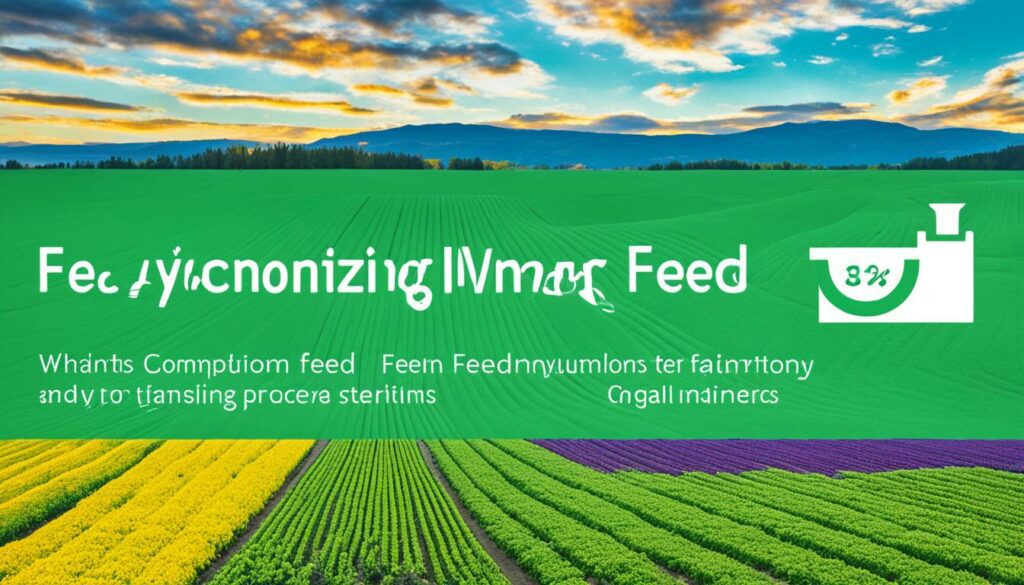
| Technology | Benefit | Impact |
|---|---|---|
| Integration with Farm Management Systems | Centralised Control | Improves Efficiency |
| Real-Time Feeding Analytics | Data-Driven Decisions | Enhances Livestock Management |
| Near-Infrared Spectroscopy | Precision Feeding | Improves Health and Yield |
| VISIOMIX Technology | Improved Precision Feeding | Reduces Waste |
The close link between digital feed tech and farm management is key. It keeps the feeding system running well and makes the farm better. Studying and improving these systems will make their use more common. This could start a new era in how we farm, one where we do it even more precisely.
Many in farming are excited about using automated feeding systems. But, getting these systems up and running can be tough. There are big initial costs and a lot of technical stuff to understand. This can slow down how well the systems work.
Switching to automated feeding needs a good amount of technical know-how. Farmers face problems when they have to figure out how to use these high-tech machines. It’s not just about buying the gear; you’ve got to make sure it’s set up right. Dr. Bob James says looking after these systems needs skill. If you don’t keep them in check, problems can pop up. This means that farmers and their teams need solid training to use these new tools well.
The first hurdle is the cost of setting up an automated feeding system. While it helps in the long run, the big price at the start can be a turn-off. Companies offer these systems, like GEA and Lely, for a lot of jobs, but they also cost a lot. For smaller farms or those without much cash, buying these systems might not be easy. These systems save on cash later, but the hefty start-up prices can be hard to manage without a solid plan.
Thinking about getting an automated feeding system means looking at all these challenges. It might also mean getting advice from people like Dr. Bob James, who know a lot. Groups like the Dairy Calf and Heifer Association and events like the Healthy Calf Conference are good places to learn how to use these systems well.
The European market for automated feeding systems is doing well. It was worth USD 4.4 billion in 2022, making it a key area globally. Experts believe it will grow to USD 6.7 billion by 2030. This growth would mean a 6.8% increase each year from 2023 to 2030.
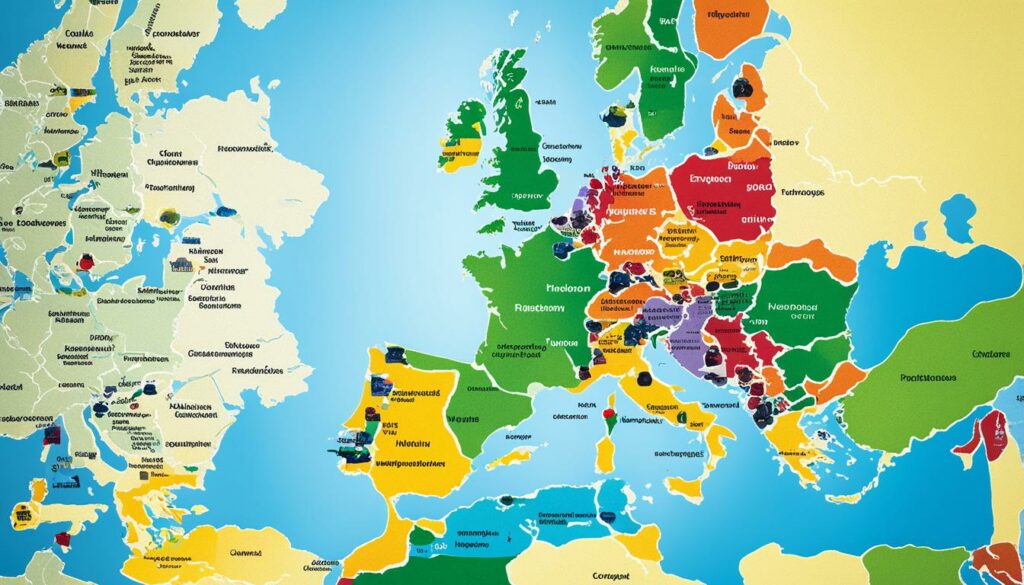
Europe offers good support and money to help the farming sector. For example, the European Union helps farmers buy new feeding tech through its Common Agricultural Policy. This type of support makes farms more modern and helps the market for automated feeding systems grow.
Europe is using more technology in farming because there aren’t enough workers. Germany and the UK are leading this charge. They are mostly using fully automated feeding systems, which are growing the quickest. By 2030, we expect to see this type of system leading the market. Currently, systems that can move along rails are the most popular. They work best for animals like cows and sheep, which make up a large part of the market.
In Europe, money and support from governments help make farms more high-tech. This is important since there are not as many workers available. As a result, there’s a big demand for automated feeding systems.
Several companies have become top players in automated feeding systems. They stand out with their new ideas, use of technology, and where they stand in the market. DeLaval Inc. and GEA Group AG are well-known faces in this scene. They are key in moving the market forward and setting high standards.
DeLaval Inc. shines in the automated feeding systems market for its constant innovation and big research efforts. They’ve introduced new technologies that help manage livestock better. By focusing on using digital tools and instant data analysis, they’ve helped a lot in the industry’s growth. They offer a wide range of products that fit different farming needs, making farming practices today a lot better.
GEA Group AG, too, has a big role in where automated feeding is going. They’ve captured more than 12% of the market with their strong engineering solutions. Their products are known for being reliable, adaptable to big farms, and built to last. GEA Group AG is also known for its push for eco-friendly farming, its use of robots, and advanced technology. They keep working on better ways to feed animals efficiently and with less impact on the environment, which is crucial for the health of our planet.
| Company | Market Share in 2023 | Technological Focus | Key Contributions |
|---|---|---|---|
| DeLaval Inc. | Over 12% | Real-time Data Analytics, Digital Integration | Enhanced Precision and Efficiency in Livestock Management |
| GEA Group AG | Over 12% | Robotics, Telemetry | Reliability, Scalability, Sustainability |
In the automated feeding market, market leaders like DeLaval Inc. and GEA Group AG keep driving big changes. Their smart innovations are vital for modern farming. They’re crucial for the success of automated feeding systems.
Automated feeding systems are changing fast, thanks to new tech and smart solutions. This change is making farming more efficient. One big step is using artificial intelligence for better and on-time feeding.
Hand-feeding calves 10 times a day is hard work. It’s also not very efficient. Automated systems make sure calves get food often, helping them grow better. These systems use tags on calves’ ears to give them the exact food they need. This means calves are healthier and farmers save time.
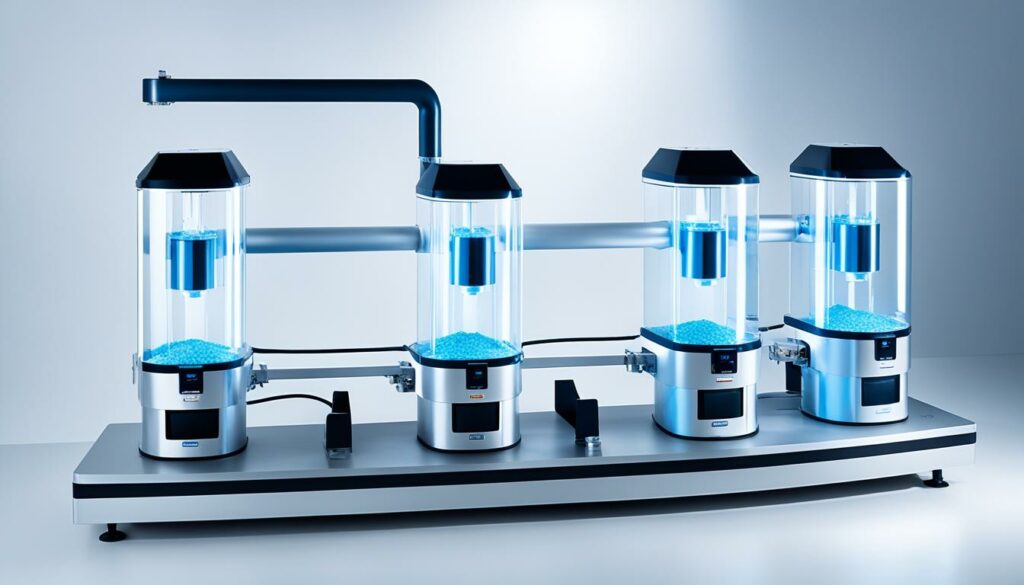
These new systems can even tell how much milk each calf is drinking. This helps farmers feed calves just right and stop when they need to. By knowing each calf, thanks to the ear tags, meals can be just what they need. This makes for happy, healthy cows and smart farming.
Dairy Farmers of Canada’s Dairy Research Cluster are big supporters of this technology. They work with universities like the University of Guelph. Together, they make sure these systems are the best they can be. This helps the cows, the farm, and the wallet.
As of 2022, more and more farmers are using these smart systems. They’re perfect for dairy farms because they help make more milk, reduce work, and keep the cows happy. Companies making farm equipment are now focusing on this high-tech trend. They are aiming to help farming be more precise and efficient.
Companies like DLL are making it easier for farmers to get this new gear. This lets dairy farms use robots to work smarter. As more people want milk, farms around the world are getting more high-tech. This is the future of dairy farming.
This wrap-up shows how automated feeding systems are changing farming and livestock care. With the world’s population set to hit 9.7 billion in 2050, boosting food production is vital. Automated systems help meet this need with their smart and effective use.
Research by Auburn University highlights the big impact of switching to automated feeding, especially on shrimp farms. Using these systems not only cut the time it takes to grow shrimp by a month but also upped the amount they could produce by half. These results suggest automation can vastly improve agriculture in many areas.
Automation isn’t just about feeding animals better. It helps farms save on costs, mainly by slashing work expenses, and it’s good for the planet. For example, these systems can cut back on harmful chemicals by 90%, helping the environment. But, the cost to start using this tech can be high, especially in poorer nations. Still, the long-term gains in productivity, eco-friendliness, and lower food prices make this a smart move for the future.
In short, automated feeding is key to modern farming. By blending new tech with traditional knowledge, we can make farming greener and more efficient. The coming years will see farming rely more on technology to feed our growing world.
Automated feeding systems are smart technologies. They are made for efficient feeding in farms and households. They use sensors and robots. Plus, they analyse data to make feeding better and control it.
Farm feeding has changed a lot. Now, we use smart machines and data for accurate feeding. Robotic systems and advanced sensors help feed animals just right.
The value hits USD 4.1 billion by 2023. It’s growing fast. This is thanks to new tech and more people using smart feeding methods.
The market growth is strong at about 7% yearly till 2032. People are starting to demand precise farming and care for the environment.
These gadgets watch over how much animals eat and what they do. They help farmers feed their livestock better and manage their farms well.
Data analysis finds patterns in the numbers. This helps farmers make smarter choices. It makes feeding better, helps the animals, and boosts the farm’s output.
It makes feeding animals more precise and saves money. Farmers get back their investment quickly. It also keeps the animals happier and healthier.
Robotic feeders use up-to-the-minute details to give the exact food at the right times. They change as needed, keeping the feeding smooth and regular.
Many studies show how well robotic feeders work. They make farms more productive and keep the animals in good health. These cases prove the value of using such systems.
They use data on animal types and needs to tailor feed times. This makes animals healthier and happier.
These systems use less feed and control feeding. That cuts waste and is good for the planet. Farming stays kind to the environment this way.
Digital feeders work together with farm management. They make feeding easier and more efficient. Everything can be watched and controlled from one place.
Putting them in needs know-how, training, and some big money up front. Farming must adapt and grow with new tech wisely and affordably.
In 2023, Europe ruled this market with half its share. It’s because of laws, aid, and tech push, especially with fewer workers in farms.
DeLaval Inc. and GEA Group AG lead with their tech and ideas. Their products and research make the market go forward.
Things like AI and clever feeders for pets are making feeding smarter and more personal. These new ideas are building the future of this field.